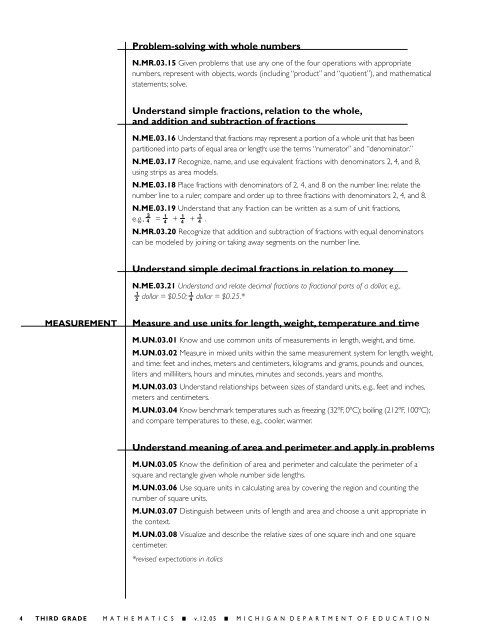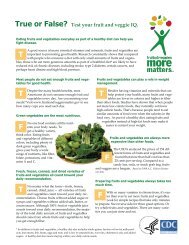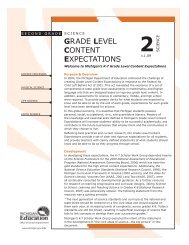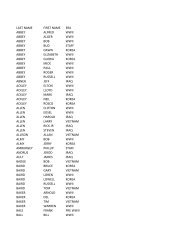Grade Level Content Expectations - State of Michigan
Grade Level Content Expectations - State of Michigan
Grade Level Content Expectations - State of Michigan
Create successful ePaper yourself
Turn your PDF publications into a flip-book with our unique Google optimized e-Paper software.
Problem-solving with whole numbers<br />
N.MR.03.15 Given problems that use any one <strong>of</strong> the four operations with appropriate<br />
numbers, represent with objects, words (including “product” and “quotient”), and mathematical<br />
statements; solve.<br />
Understand simple fractions, relation to the whole,<br />
and addition and subtraction <strong>of</strong> fractions<br />
N.ME.03.16 Understand that fractions may represent a portion <strong>of</strong> a whole unit that has been<br />
partitioned into parts <strong>of</strong> equal area or length; use the terms “numerator” and “denominator.”<br />
N.ME.03.17 Recognize, name, and use equivalent fractions with denominators 2, 4, and 8,<br />
using strips as area models.<br />
N.ME.03.18 Place fractions with denominators <strong>of</strong> 2, 4, and 8 on the number line; relate the<br />
number line to a ruler; compare and order up to three fractions with denominators 2, 4, and 8.<br />
N.ME.03.19 Understand that any fraction can be written as a sum <strong>of</strong> unit fractions,<br />
e.g., 3 4 = 1 4<br />
+ 1 4<br />
+ 1 4 .<br />
N.MR.03.20 Recognize that addition and subtraction <strong>of</strong> fractions with equal denominators<br />
can be modeled by joining or taking away segments on the number line.<br />
Understand simple decimal fractions in relation to money<br />
N.ME.03.21 Understand and relate decimal fractions to fractional parts <strong>of</strong> a dollar, e.g.,<br />
1<br />
2<br />
dollar = $0.50; 1 4<br />
dollar = $0.25.*<br />
MEASUREMENT<br />
Measure and use units for length, weight, temperature and time<br />
M.UN.03.01 Know and use common units <strong>of</strong> measurements in length, weight, and time.<br />
M.UN.03.02 Measure in mixed units within the same measurement system for length, weight,<br />
and time: feet and inches, meters and centimeters, kilograms and grams, pounds and ounces,<br />
liters and milliliters, hours and minutes, minutes and seconds, years and months.<br />
M.UN.03.03 Understand relationships between sizes <strong>of</strong> standard units, e.g., feet and inches,<br />
meters and centimeters.<br />
M.UN.03.04 Know benchmark temperatures such as freezing (32ºF, 0ºC); boiling (212ºF, 100ºC);<br />
and compare temperatures to these, e.g., cooler, warmer.<br />
Understand meaning <strong>of</strong> area and perimeter and apply in problems<br />
M.UN.03.05 Know the definition <strong>of</strong> area and perimeter and calculate the perimeter <strong>of</strong> a<br />
square and rectangle given whole number side lengths.<br />
M.UN.03.06 Use square units in calculating area by covering the region and counting the<br />
number <strong>of</strong> square units.<br />
M.UN.03.07 Distinguish between units <strong>of</strong> length and area and choose a unit appropriate in<br />
the context.<br />
M.UN.03.08 Visualize and describe the relative sizes <strong>of</strong> one square inch and one square<br />
centimeter.<br />
*revised expectations in italics<br />
4 T H I R D G R A D E M A T H E M A T I C S ■ v. 1 2 . 0 5 ■ M I C H I G A N D E P A R T M E N T O F E D U C A T I O N






